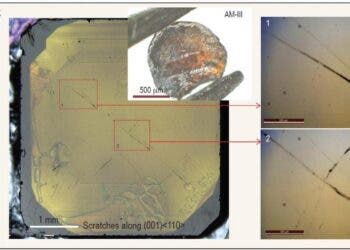
An exotic and beautiful type of glass found in the Sahara desert has a cosmic origin, according to a new study. After analyzing the chemical makeup of Libyan desert glass — a naturally occurring glass whose striking yellow color made it a much-sought-after decorative material — researchers found that it was produced by ancient meteorite impacts.
Cosmic glass fit for kings

The rare Libyan desert glass has been prized for its beauty for thousands of years. The glass — the purest natural silica glass ever found on Earth — is generally yellow in color and can be very clear, although most pieces are milky and may even contain tiny bubbles, white wisps, and inky black swirls.
By one estimate, over a thousand tons of Libyan desert glass are strewn across the deserts of eastern Libya and western Egypt. Most are the size of pebbles, although some chunks can have a considerable size and weight — the biggest piece ever found weighs around 26 kg.
Local inhabitants in the Neolithic period made tools out of the glass, and later the Egyptians used it to fashion jewelry. In fact, the carved stone on the breastplate of the famous Egyptian pharaoh Tutankhamun was made of Libyan desert glass. But these piece of glass were created long before King Tut was born — about 29 million years by one estimate.

For more than a hundred years, scientists have debated what forces could have created the enchanting glasses. There are two major hypotheses that explain their formation: either a meteor impact or an airburst (an atmospheric explosion which happens when meteoroids explode in the lower atmosphere) was responsible. A recently published study supports the former theory.
In a new study, Aaron Cavosie from Curtin University in Australia and colleagues performed chemical analyses of Libyan desert glass samples that unequivocally supports the meteorite formation theory.
While they were examining zircon minerals embedded in the glasses, the researchers found traces of another mineral called reidite. This mineral only forms in high pressure and heat — so far, it hasn’t been found anywhere other than meteorite impact craters.
“Both meteorite impacts and airbursts can cause melting, however, only meteorite impacts create shock waves that form high-pressure minerals,” says Cavosie.
“So finding evidence of former reidite confirms it was created as the result of a meteorite impact.”
Whatever meteorite impacted the desert all those millions of years ago, it must have caused a gigantic explosion. It vitrified (glassified) a huge area, resulting in a broad range of glasses ranging from cloudy dark to stunningly luminous lemon yellow — all depending on the kind of contaminants that dissolved into the liquid silica created by the powerful impact.

The findings published in the journal Geology are useful for establishing how often near-Earth objects come in contact with our planet’s surface. The study seems to suggest that the kind of impacts that are powerful enough to create Libyan desert glass are, thankfully, quite rare.
“Meteorite impacts are catastrophic events, but they are not common,” says Cavosie.
“Airbursts happen more frequently, but we now know not to expect a Libyan desert glass-forming event in the near future, which is cause for some comfort.”






